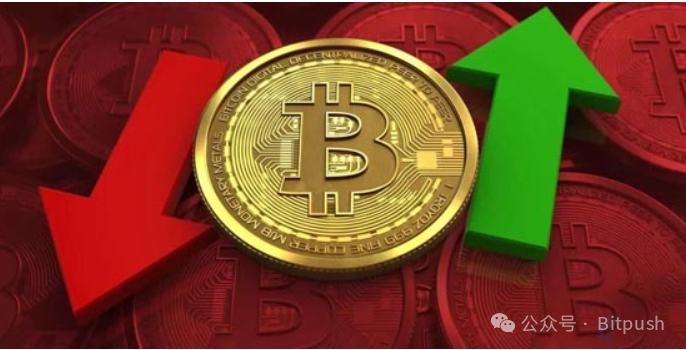US stocks and BIT have been highly correlated, why have BIT and US stocks diverged in the past two days? On October 9, the sharp drop in BIT may be related to the new documentary "Cryptopia: Bitcoin's Dark Secrets" on HBO, what is the reason behind this? "Golden September, Silver October", can BIT stage an October offensive? The author believes that although there are indeed many positive signs, overall, some unexpected events may hinder the October rise of BIT, and the overall situation still needs to be cautious.

BIT and US stocks decouple again, A-shares cooling may help capital reflux
BIT and US stocks have been highly correlated, but they have diverged again in the past two days. In the early morning of Beijing time on the 10th, US stocks closed higher on Wednesday, with the Dow Jones and S&P 500 indices both hitting new highs. Against the backdrop of US stocks hitting new highs, BIT continued to decline. What is the reason behind this?
The global financial market is like a pool of water, where the money-making effect is, it will become a gathering place for capital, and there are obvious signs of capital fleeing from the crypto market to the A-share market. Recently, the fever of making money and getting rich in the A-share market has swept the world. On October 8, the trading volume of the Shanghai and Shenzhen markets reached a record high of 3.45 trillion yuan, an increase of over 800 billion yuan compared to September 30.
Almost all major sectors rose, with securities and semiconductors collectively exploding. Individual stocks continued to rise broadly, with 5,029 stocks rising, 791 stocks hitting the daily limit, and 291 stocks falling. More unusually, on that day, 100 broad-based ETFs hit the daily limit, and the ETF market saw a surge in trading. The latest weekly data released by the global capital flow monitoring agency EPFR shows that in the week ended October 2, the emerging market equity funds tracked by EPFR recorded the second largest weekly inflow of the year, marking the 18th consecutive week of net inflow, and almost all of this inflow of funds went to the Chinese market.
Further Reading: China's A-shares are crazy again! Brokerage apps crash, economists suggest: Accelerate stimulus with record deficit to boost China's economy
David Scutt, senior strategist at Jazeera Group, told reporters that the direction of capital flow is always the key, and currently global investors' positions in the Chinese stock market are still relatively light. Citing data from Goldman Sachs channels, he said that while hedge funds have quickly increased their positions in the Chinese market recently, they are still in the 55th percentile of the 5-year range, while in January 2023 this figure reached the 91st percentile. This also means that the dramatic changes in the market may lead to further increases in foreign capital allocations to the Chinese stock market.
In addition to the sustained large inflows of capital, China has also continued to introduce positive policies, and most people in the A-share market believe this will be an unprecedented bull market. In addition to the two structural monetary policy tools created by the central bank, on September 24, the China Securities Regulatory Commission issued the "Opinions on Deepening the Reform of the Mergers and Acquisitions Market for Listed Companies" to further stimulate the vitality of the mergers and acquisitions market, support listed companies to inject high-quality assets, and enhance investment value; The "Regulatory Guidelines for Listed Companies No. 10 - Market Value Management (Draft for Comments)" was released for public comment, requiring listed companies to improve the quality of listed companies as the basis, and promote the enhancement of the investment value of listed companies.
In addition, on September 26, the Central Financial Office and the China Securities Regulatory Commission jointly issued the "Guiding Opinions on Promoting the Entry of Medium and Long-term Funds into the Market" to unblock the bottlenecks for social security, insurance, wealth management and other funds to enter the market, and strive to boost the capital market.
The A-share market is currently an investment depression in the global financial market, and there are obvious signs of capital inflows, which has led to a significant outflow of capital from the crypto market. This is specifically reflected in the continuous negative premium of USDT and the outflow of capital from BIT ETFs. However, with the recent crazy rise in A-shares, the market has seen a pullback, and it is expected that the A-share market will need to go through a period of adjustment, and the outflow of capital from the crypto market is expected to slow down. However, considering that the current valuation of A-shares is relatively low, the capital may not rule out further fleeing from the crypto market or reducing investment in crypto assets, which is undoubtedly not conducive to the rise of BIT.

Potential U.S. government sale could put pressure on Bitcoin
Since June this year, a major sell-off wave in Bitcoin has come from the sell-off pressure brought by the German government, the U.S. government, and the Mt.Gox compensation. Recently, the expected sell-off by the U.S. government may also become a potential factor in the Bitcoin downturn. According to a post by Lookonchain, the U.S. government seems to be able to freely sell the 69,370 BTC seized from Silk Road, as the U.S. Supreme Court refused to hear the Battle Born Investments case regarding the ownership of the 69,370 BTC (about $433 million) seized from Silk Road on October 7, allowing the government to fully control the seized funds.
The author believes that the Biden administration may not be very friendly to the crypto market, and the U.S. government may likely conduct a sell-off. The last time the U.S. government sold was two months ago, when the U.S. government moved 29,800 BTC (about $202 million), of which 10,000 BTC (about $59.4 million) were transferred to CoinbasePrime. Currently, the market is also expressing concerns about the crypto prospects after the victory of Democratic Vice President Kamala Harris. Bernstein analysts said: If Kamala Harris wins, Bitcoin may retest the $40,000 range.
Further reading: Bitcoin plunges below $60,000! Bernstein: If Harris wins, BTC may retest $40,000 support
In addition to the potential sell-off by the U.S. government, the new HBO documentary "Cryptopia: The Bitcoin Revolution" may also cause some market panic and be a major reason for the Bitcoin plunge on October 9. This new HBO film, directed by the famous director Cullen Hoback known for solving mysteries, mainly tries to reveal the identity of Satoshi Nakamoto. This has sparked widespread market attention. Currently, the value of the BTC held by Satoshi Nakamoto is $68 billion, which is an extremely large digital asset. For the market, if this person is indeed confirmed as the founder of Bitcoin, it would certainly be an exciting event, but it may not be so for the market trend.
The controversy around the new HBO documentary is huge. Cullen Hoback believes that Peter Todd is the evidence that he is Satoshi Nakamoto, but many professionals in the crypto market do not agree. Some professionals point out that HBO has got the timeline of Peter Todd wrong in the entire documentary, mistakenly thinking that he is Satoshi Nakamoto, when in fact in 2008 Peter Todd was not even 16 years old, which is very inconsistent with his age, and his biography and experience are also very different from what is known about Satoshi Nakamoto. Moreover, Todd has long served as an advisor to multiple projects, and if he were really Satoshi Nakamoto, his BTC wallet would not have remained completely untouched for so many years. Peter Todd himself is also extremely dissatisfied and publicly denies being Satoshi Nakamoto, repeatedly stating on social media that Hoback's theory is completely absurd.
Further reading: Is the developer Peter Todd the creator of Bitcoin? He himself slams the HBO documentary: This is too absurd

September and October? Bitcoin still needs technical drivers
Although Bitcoin has been performing weakly recently, the market remains optimistic about its future performance, with the main support being the growth in the market capitalization of USDT.
CryptoQuant data shows that the liquidity of stablecoins continued to grow to a record $169 billion at the end of September, up 31% year-to-date (YTD). The dominant one is still Tether's USDT, whose market cap has increased by $28 billion to nearly $120 billion, accounting for 71% of the market share; and Circle's USDC, whose market cap has increased by $11 billion to $36 billion, up 44% YTD, accounting for 21% of the market share. The record number of US dollar stablecoins and the surge in large-scale BTC transactions may lay the foundation for a broader BTC rally in the coming weeks, keeping the asset's bullish seasonality intact in October.
Further reading: V-shaped recovery! Bitcoin surges past $63K, Ethereum eyes $2,500, China-US tensions become the key to "Uptober"
The author believes that the bullish expectations for the A-share market are very obvious at the moment, and the global financial markets are all speculating on the expectations for the A-share market, which will essentially lead to a capital outflow or reduced investment in the crypto market. In addition, the outcome of the U.S. election will be a very important factor. If Trump is elected, as he has actively embraced cryptocurrencies, this will undoubtedly be a direct stimulus to Bitcoin; but if Harris is elected, the outcome for Bitcoin is hard to say, and a further deep pullback cannot be ruled out, which will have to wait until November. Overall, the author is cautious about Bitcoin's performance in October. From a longer-term perspective, the crypto market still needs technical drivers, and simple financial stimulus is unlikely to sustain a prolonged prosperity.






